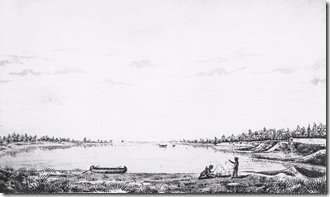The passage below is from “The Villages Within,” nominated for the Toronto Heritage Awards.
Simcoe sailed from Niagara-on-the-Lake and arrived at the Toronto Carrying Place in the early hours of July 30, 1793. He moored the HMS Mississauga at the mouth of the Humber River and awaited daylight to venture ashore. When he stepped on deck at day’s first light, the scenery that greeted him contained nothing but trees—trees—and more trees.
It was a virgin landscape.
Today, some critics feel that this was the last time anyone employed the word
“virgin” to refer to anything in Toronto. Considering the city’s propensity toward the prim and proper, this is a very strange accusation.
On this sunny day in August 1793, to say that Simcoe was “up the stump” would have been an understatement. The royal suite at the King Eddie was obviously not available, and so he was forced to pitch his canvas tents beside the lake.
To make matters worse, the tents were second hand, Simcoe having purchased them at an auction in London. At one time, they had been owned by Captain James Cook of “South Pacific” fame. Contrary to common belief, James Cook had nothing to do with the Rodgers and Hammerstein musical of that name. He merely explored the Pacific Ocean for the British government and discovered the Sandwich Islands.
It is a pernicious rumour that Cook later authored the “Sandwich Section” of the Michelin Guide, and named the “two-faced open sandwiches” in honour of British politicians. Though he may have considered them five-star men, he knew that were crusty and their edicts were difficult to swallow.
In the encampment beside the lake, we doubt that Mrs. Simcoe teased her husband about his choice of pre-owned tents. However, we cannot help but wonder if behind the governor’s back, the troops were quietly crooning the words of the song “Second-Hand Rose.”
If Simcoe ever became aware of such disrespectful behaviour, he would have firmly put a stop to it, fearing that the men might eventually begin referring to him as “Rosie.” It is fun to speculate what might have happened if he had received such a humorous nickname. Would he have received offers to perform on the stages of gay nightclubs or “women’s only” strip-joints? Such entreaties would hardly have been dignified proposals to suggest to a representative of the Crown. Fortunately, the point was moot, as the settlement lacked even a tavern, never mind a nightclub.
Within a day or two of their arrival, Mrs. Simcoe toured the small settlement huddled along the shoreline. The first evening, she undoubtedly discovered that the candles in the windows of the few log cabins at Toronto hardly qualified it as a place of “bright lights.” In addition, today, we know that some of the colonial officials were not exactly bright lights either. It wasn’t just the floorboards of the homes in Toronto that were “plank-thick.
The above passage from “The Villages Within,” was nominated for the Toronto heritage Awards. It is a tongue-in-cheek account of the history of Toronto. The book also provides in-depth studies of Queen Street West, the Kensington Market, and the historic buildings in the King/Spadina area.
To order this book : http://bookstore.iuniverse.com/Products/SKU-000175211/The-Villages-Within.aspx
